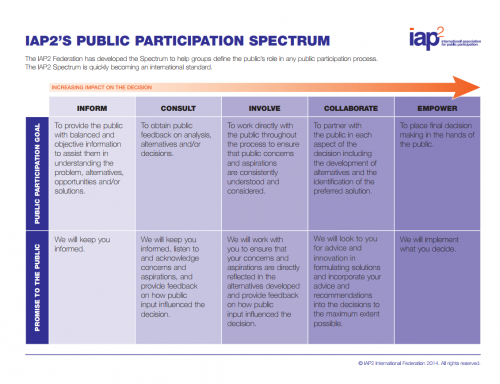Public participation beyond public comment at open meetings
How can the public engage in government decision-making outside of public comment at open meetings?
In a previous article, we examined why public comment takes place at open public meetings, and why it may not be the most effective method of citizen participation in government decision-making processes. So, if not public comment, then what? How are citizens supposed to engage in government decision-making processes, and how can government officials make sure they are getting good citizen input on the decisions they are making?
The answer is that there are many different ways this can be accomplished. A person could write a letter to their elected officials informing them of an opinion on an issue. An elected official may hold regular open meeting times, often at a local coffee shop or restaurant, or at their office, where the public can come and discuss issues with them. Governmental bodies often hold public hearings or town hall meetings that are meant to be an opportunity for members of the community to give input on a specific issue. These can provide useful input, or at least a chance for residents voices to be heard, but not always. Sometimes they end up like a scene from the show Parks and Rec.
While there are many ways the public can participate in local government decisions, and many things local governments can do to encourage (or discourage) public participation, one of the most important aspects of any interaction between government and its constituents is clear expectations. Governments and government officials, when soliciting public input, must be clear on how that input will be used.
If I, as a resident of the fictitious Spartan County, give my county commissioner input on an issue, with the expectation that it will be used to help guide their vote, but then feel my input is disregarded, I’m less likely to participate in the future. However, if my commissioner tells me up front how they’re going to use my input, or what my role is in the process, then whether I’m helping make the decision, or simply giving feedback on a decision that’s been made, at least I know my place in the process and I’m more likely to continue to participate.
The International Association of Public Participation has developed a Public Participation Spectrum, which is used to help define the public’s role in any participation process. The spectrum ranges from “inform,” where the governmental body commits to providing the public with objective information about the decision, to “empower,” where the public actually makes the final decision.

In the following articles, we’ll take a look at each part of the spectrum in detail, talking about what it means, and giving some examples of how and when each point on the spectrum might be appropriate for engaging the public in a decision-making process.
Those in Michigan State University Extension that focus on Government and Public Policy provide various training programs, which are available to be presented in your county. Contact your local Government and Public Policy educator for more information.



 Print
Print Email
Email